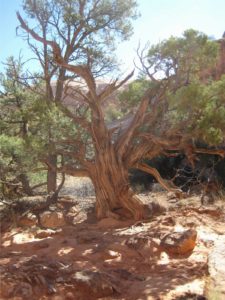The word ‘desert’ implies ‘deserted,’ ‘forsaken,’ ‘abandoned.’ Before coming to the desert of the Colorado Plateau, I  imagined this place as an expanse of lifeless rocks, with a few tumbleweeds blowing in the wind. I was shocked to find that this place is not deserted at all. This area gets only seven inches of rain each year, yet biodiversity flourishes. There are more than cactus here- I have seen flowers of every color, many types of grasses, shrubs, and even trees. How can all these plants grow out of this parched sand? How can so little water create so much life?
imagined this place as an expanse of lifeless rocks, with a few tumbleweeds blowing in the wind. I was shocked to find that this place is not deserted at all. This area gets only seven inches of rain each year, yet biodiversity flourishes. There are more than cactus here- I have seen flowers of every color, many types of grasses, shrubs, and even trees. How can all these plants grow out of this parched sand? How can so little water create so much life?
Nestled in the canyons along the Dirty Devil River is a hidden paradise; cottonwood trees dominate the riparian zones and sandy washes between layered cliffs of Navajo, Kayenta, and Wingate sandstone. I was surprised to find deciduous trees here with such broad leaves, as they need so much water to survive. They reach their taproots deep into the earth, and their branches high towards the sun. Their fresh green buds contrast sharply with the surrounding rock layers that have been here for over 200 million years. Ravens and hawks nest in their branches, beavers build dams from their wood, and owls live in the holes of their trunks. Hundreds of years ago, native people ate these spring buds, and made scurvy-preventing medicine from the tree’s inner bark. Today, we make camp under their cool shade, watch their cotton-covered seeds float in the sunlight like a light snowfall, and step across the silvery blanket of their dead leaves on the dry earth.
In even drier areas away from streams and washes, intermixed with pinyon pine, juniper trees flourish. The Navajo people ate the blue “berries” (actually modified cones) of this conifer, and used them as beads. They also made medicine from juniper to treat the flu. Now, we marvel at their scaly green leaves, their fresh, pine scent, and their gnarled branches. This tree has adapted to life in this harsh climate- in times of drought, it can shut off water and nutrients to some of its branches, killing parts of itself so that the whole can survive. I touch the shredded bark of a nearby juniper. Many years have these weathered trees stood against the heat and the cold, the thirst and the flood. These trees can survive for thousands of years. How old is this one?
It is amazing where life can bloom. Poking their heads out of the sand are white primroses, orange globe mallows, and the delicate pink flowers of the prickly pear cactus. The adaptability of the plants and animals that live here is incredible. The thousand year old juniper, the budding cottonwood, the flowering cactus; their survival truly proves the resilience of life. The songs of the birds, the flutter of bats, the cougar leaving prints in the mud; many think of the desert as a barren wasteland. But look around, this place is very much alive.